CW Leonis (IRC +10216) is a variable carbon star located approximately 310 light-years away in the constellation Leo. It is the nearest carbon star to the Sun. With an apparent magnitude of around 14.5, it is invisible to the unaided eye. The star is surrounded by a cloud of expelled material, known as the Peanut Nebula.
Star type
CW Leonis is a carbon star of the spectral type C9,5e. It has a mass between 0.7 and 0.9 solar masses and a radius 560 times that of the Sun. With an average surface temperature of 2,300 K, it is about 8,500 times more luminous than the Sun.
Carbon stars are evolved giants on the asymptotic giant branch whose atmospheres contain more carbon than oxygen. As these elements combine in the upper layers of these stars, they form carbon monoxide. The gas consumes most of the oxygen in the atmosphere, giving the stars a strikingly red appearance.
CW Leonis is a pulsating star whose brightness, luminosity and temperature change over the course of its pulsation cycle. The star has a pulsation period of 649 days. Its brightness varies by around 2 magnitudes. At maximum, it shines with 11,850 solar luminosities. Its temperature is typically in the range between 1,915 and 2,105 K. The star emits most of its energy in the infrared band.
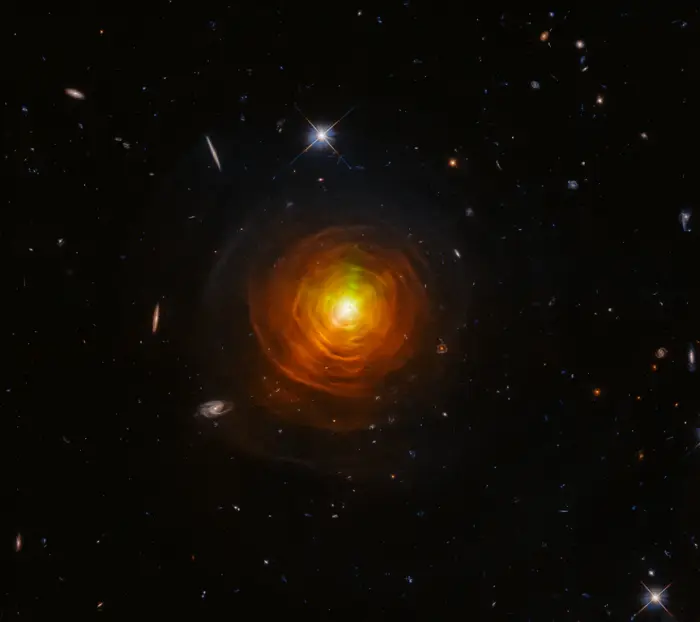
CW Leonis glowers from deep within a thick shroud of dust in this image from the NASA/ESA Hubble Space Telescope. Lying roughly 400 light-years from Earth in the constellation Leo, CW Leonis is a carbon star — a luminous type of red giant star with a carbon-rich atmosphere. The orange-red “cobwebs” are dusty clouds of sooty carbon engulfing the star. They were created from the outer layers of CW Leonis being thrown out into the inky black void. The carbon, cooked up through nuclear fusion in the star’s interior, gives it a carbon-rich atmosphere. Blasting the carbon back into space provides raw material for the formation of future stars and planets. All known life on Earth is built around the carbon atom. Complex biological molecules consist of carbon atoms bonded with other common elements in the universe. Image credit: ESA/Hubble & NASA, T. Ueta, H. Kim (CC BY 4.0)
CW Leonis is classified as a Mira variable. Mira-type stars are pulsating variable stars that appear very red and have pulsation periods of over 100 days. These stars are typically red giants on the asymptotic giant branch (AGB) that vary in brightness with amplitudes of over 1 magnitude in infrared wavelengths and 2.5 magnitudes at visual wavelengths.
Giants in the thermally pulsing AGB stage eject their outer envelopes to form planetary nebulae within only a few million years. Other stars in this class include the prototype Mira (Omicron Ceti) in the constellation Cetus, Hind’s Crimson Star (R Leporis) in Lepus, IK Tauri in Taurus, Chi Cygni in Cygnus, R Hydrae in Hydra, R Carinae and S Carinae in Carina, and R Cassiopeiae in Cassiopeia.
CW Leonis is estimated to have had an initial mass of 3 – 5 solar masses. It has expelled most of its mass through a powerful stellar wind as it reached the final stages of its life cycle. The star is not massive enough to end its life as a supernova. Instead, it will keep losing its atmosphere and eventually become a white dwarf. Astronomers have estimated a mass of 0.7 to 0.9 solar masses for the stellar core that will become a white dwarf. The carbon that is expelled into the interstellar medium may serve as raw material for the formation of a new generation of stars and planets.
The “cobwebs” of material surrounding CW Leonis that can be seen in the Hubble image of the star formed from the star’s outer layers that were ejected into space. The complex structure and clumpiness of the dust envelope, including unfinished shells and partial arcs, may be shaped by the magnetic field of CW Leonis.
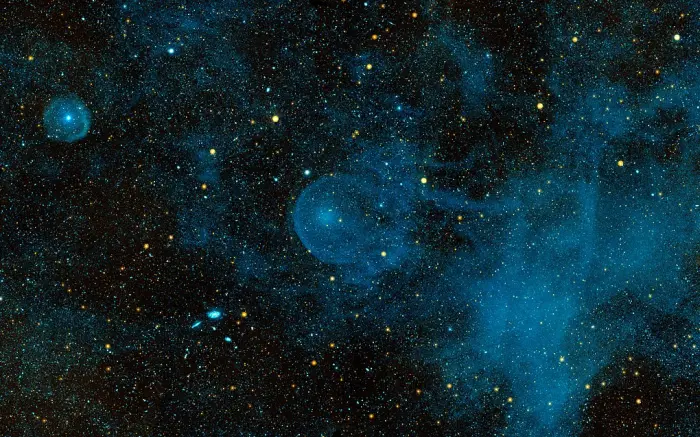
A runaway star, plowing through the depths of space and piling up interstellar material before it, can be seen in this ultraviolet image from NASA’s Galaxy Evolution Explorer. The star, called CW Leonis, is hurtling through space at about 204,000 miles per hour (91 kilometers per second), or roughly 265 times the speed of sound on Earth. It is shedding its own atmosphere to form a sooty shell of discarded material. This shell can be seen in the center of this image as a bright circular blob. CW Leonis is moving from right to left in this image. It is travelling so quickly through the surrounding material that it has formed a semi-circular bow shock in front of itself, like a boat moving through water. This bow shock is made of superheated gas, which flows around the star and is left behind in its turbulent wake. This blown-out bubble is 2.7 light-years across, which is more than half the distance from our Sun to the nearest star, or 2,100 times the size of Pluto’s orbit. The size of the bubble (called the “astrosheath”) has allowed astronomers to estimate that CW Leonis has been shedding its atmosphere for about 70,000 years. This is part of the star’s natural life cycle as it runs out of hydrogen fuel and gradually throws off its outer layers to expose its bare, dying core. This core is called a white dwarf, and is the end product of all low-mass stars like our Sun. Image credit: NASA/JPL-Caltech (PD)
Observations with the Atacama Large Millimeter/submillimeter Array (ALMA) in northern Chile and archival ground-based astrometric measurements have provided strong evidence for the presence of orbital motion, indicating a binary companion.
Any companions cannot be easily detected because of the high luminosity of CW Leo and the large, complex, dynamically evolving envelope that surrounds the star. The gravity of an unseen companion may contribute to the overall shape of the nebula.
The beams of light radiating outwards from the star have changed noticeably in brightness in recent decades. The cause of the brightness changes is uncertain.
CW Leonis is surrounded by a carbon-rich gaseous envelope that contains at least 1.4 solar masses of material expelled from the star. The envelope is at least 69,000 years old. The star is losing an estimated (1–4) × 10−5 solar masses of material per year. The optically thick circumstellar dust shell surrounding CW Leonis is known as the Peanut Nebula.
Astronomers have detected many molecules in the circumstellar shell, including nitrogen, oxygen, water, silicon, and iron. Some sources have suggested that the star melted orbiting comets as it started expanding, but more recent studies indicate that water forms naturally in the atmosphere of CW Leonis and other carbon stars.
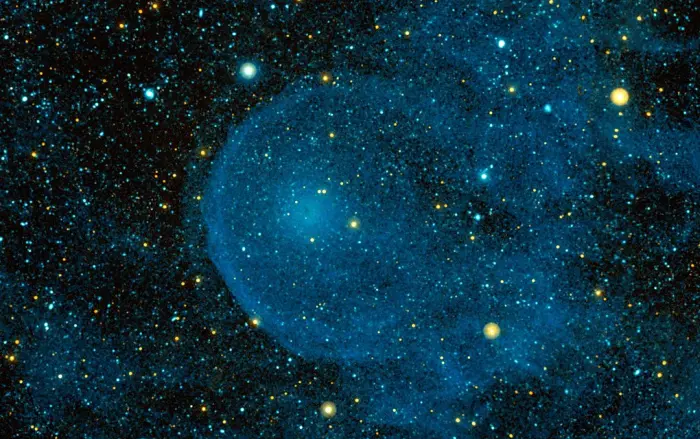
CW Leonis and the Peanut Nebula, image credit: NASA/JPL-Caltech (PD)
Facts
CW Leonis was discovered by a group of astronomers led by American astrophysicist Eric Brecklin in 1969. The astronomers detected the star after observations with the 62-inch Caltech Infrared Telescope at Mount Wilson Observatory in California.
At the time of discovery, CW Leonis was found to be the brightest source at a wavelength of 5 μm outside the solar system.
Name
CW Leonis does not have a proper name. It is commonly referred to by its variable star designation CW Leonis or by its Two-Micron Sky Survey or Caltech infrared catalog designation IRC +10216. The Caltech infrared catalog contains around 5,000 infrared sources – mostly M-type stars – between the declinations +15 and -15 degrees. It was published in 1969.
Location
CW Leonis lies in the region of the Sickle of Leo, a relatively bright asterism that outlines the celestial Lion’s head and mane. The star forms an almost equilateral triangle with Regulus and Eta Leonis and lies about a quarter of the way from Subra to Adhafera.
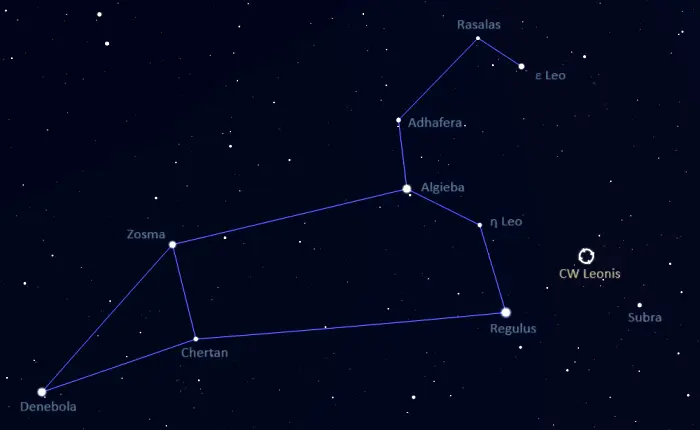
The location of CW Leonis, image: Stellarium
Constellation
CW Leonis is located in the zodiac constellation of Leo (the Lion). Leo is one of the 48 ancient constellations catalogued by the Greco-Roman astronomer Ptolemy in the 2nd century CE. In Greek mythology, the constellation is associated with the Nemean lion, a monster that met its end at the hands of Heracles as part of the hero’s twelve labours. The Greek hero is represented by the constellation Hercules.
Leo is the 12th largest constellation in the sky, occupying an area of 947 square degrees of the predominantly northern sky. It is one of the 15 equatorial constellations and is visible from most locations on Earth for at least part of the year.
Leo contains five stars brighter than magnitude 3.0 and is easily recognizable because its brightest stars form an asterism known as the Sickle. The asterism represents the Lion’s head, mane and shoulders. Regulus, the constellation’s brightest star, appears at the base of the Sickle and marks the Lion’s heart. The fainter Denebola lies at the opposite end of the constellation and marks the Lion’s tail.
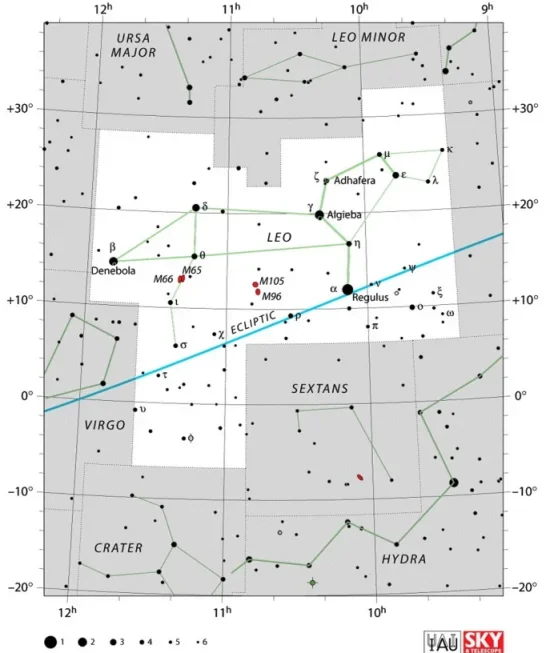
Leo constellation map by IAU and Sky&Telescope magazine
Other notable stars in Leo include the red dwarf Wolf 359, one of the closest stars to the solar system, Icarus (MACS J1149 LS1), one of the most distant stars ever discovered, Caffau’s Star (SDSS J102915+172927), one of the oldest stars known, the binary star Gamma Leonis (Algieba), the white giant Adhafera (Zeta Leonis), the Mira variable R Leonis, the yellow bright giant Epsilon Leonis, the hot blue supergiant Rho Leonis, and the orange giant Rasalas (Mu Leonis).
Deep sky objects in Leo include the bright galaxy groups known as the Leo Triplet (Messier 65, Messier 66 and NGC 3628) and the Leo I Group (Messier 95, Messier 96 and Messier 105), the compact galaxy group Hickson 44 (HCG 44, Arp 316), the Leo Ring, a vast cloud of gas in the orbit of two galaxies, and the gravitationally lensed system of two distant galaxies nicknamed the Cosmic Horseshoe. The constellation is also home to the protoplanetary Frosty Leo Nebula, the Silverado Galaxy (NGC 3370), the colliding pair of galaxies NGC 3226 and NGC 3227, the Owl Galaxy (NGC 3758), and the elliptical galaxy NGC 3842, the brightest member of the Leo Cluster (Abell 1367).
The best time of the year to see the stars and deep sky objects in Leo is during the month of April, when the constellation appears higher in the sky in the early evening. The entire constellation is visible from locations north of the latitude 65° S.
The 10 brightest stars in Leo are Regulus (Alpha Leo, mag. 1.40), Algieba (Gamma Leo, mag. 2.08), Denebola (Beta Leo, mag. 2.113), Zosma (Delta Leo, mag. 2.56), Epsilon Leonis (mag. 2.98), Chertan (Theta Leo, mag. 3.324), Adhafera (Zeta Leo, mag. 3.33), Eta Leonis (mag. 3.486), Subra (Omicron Leo, mag. 3.52), and Shaomin (Rho Leo, mag. 3.9).
CW Leonis
| Spectral class | C9,5e |
| Variable type | Mira |
| Apparent magnitude (V) | 14.5 |
| Apparent magnitude (R) | 10.96 |
| Apparent magnitude (J) | 7.34 |
| Apparent magnitude (H) | 4.04 |
| Apparent magnitude (K) | 1.19 |
| Distance | ~310 light-years (90 parsecs) |
| Parallax | 10.56 ± 2.02 mas |
| Proper motion | RA: 33.84 ± 0.7 mas/yr |
| Dec.: 10 ± 0.7 mas/yr | |
| Mass | 0.7 – 0.9 M☉ |
| Luminosity | 8,500 L☉ (average), 11,850 L☉ (maximum) |
| Radius | 560 R☉ |
| Temperature | 2,300 K (1,915 – 2,105 K) |
| Constellation | Leo |
| Right ascension | 09h 47m 57.40632s |
| Declination | +13° 16′ 43.5648″ |
| Names and designations | CW Leonis, CW Leo, Peanut Nebula, IRC+10216, PK 221+45 1, PN G221.4+45.0, LEDA 1427054, RAFGL 1381, CGCS 2619, PCCS2 143 G221.44+45.06, SCM 50, TIC 258671744, SDSS J094757.42+131643.6, ATO J146.9891+13.2788, CRTS J094757.4+131643, Zel 0945+135, JCMTSE J094757.1+131644, IRAS 09452+1330, 2MASS J09475740+1316435, Gaia DR3 614377930478412032 |